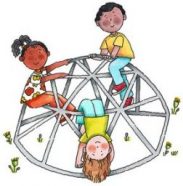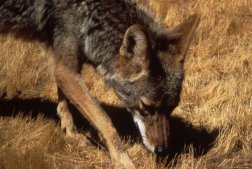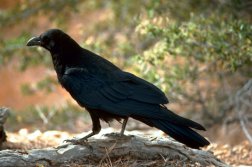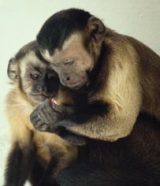Fair play
Studying dogs, monkeys, and other animals at play can teach us about fairness and cooperation.
By Emily Sohn
Let’s face it. As much as you care about your friends, you probably don’t always get along with them. Sometimes, you fight over who gets to use the only swing in the playground. You argue over who gets the last cookie. You might even start shoving or hitting each other. Usually, the spat ends with a laugh, and you play together again the next day.
 |
|
Through play, kids learn how to get along.
|
“Through play, youngsters of all ages learn the rules of social conduct,” says Marc Bekoff. He’s an animal behaviorist at the University of Colorado in Boulder. Bekoff has spent years studying similarities between play behavior in animals and play behavior in people.
“The things I see in captive animals, I see in wild animals and in kids all the time,” he says.
By studying how animals interact with each other, especially during play, Bekoff and other researchers are discovering a sense of fairness in a wide range of creatures, from coyotes to monkeys to birds.
The research may help explain how people learn to play fair. And, while scientists have traditionally favored the idea that competition determines how animals behave, the new work suggests that cooperation deserves just as much attention.
Serious play
Play, as Bekoff puts it, is a serious business.
When they push each other around, animals get exercise. They develop skills, such as hunting and mating. Some studies even suggest that playing more leads to bigger brains that are better at reasoning and learning.
Through play, animals find limits, such as how hard they can hit one another before their playmates get upset. And they learn how to apologize, forgive, and trust each other, just like kids do.
“Animals have to negotiate fairness,” Bekoff says. “If I cheat you, others won’t play with me. If Johnny sees Harry beat up Mary, nobody’s going to play with Harry.”
 |
|
Like dogs, coyotes use play to develop hunting skills. Play also allows the animals to explore social situations and develop the behavior necessary to be a member of a social group.
|
| R.H. Barrett, U.S. Fish and Wildlife Service |
Bekoff has been studying wolves, coyotes, and dogs for more than 15 years. To anyone who has ever watched a pile of squirming puppies, he says, it may seem obvious that they play.
The furry tykes roll around and swat each other. Usually, they look like they’re having a rollicking good time until one pushes another too far and someone skulks away. Because people tend to read too much into animal behavior, though, scientists can’t rely on such stories alone.
Instead, Bekoff has turned to videotape. He and his colleagues have developed a set of about 60 coded terms to describe the puppy behavior they see, including bites to different parts of the body, pawing, body slamming, shoving, head shaking, and standing over another animal’s back.
The researchers film groups of animals interacting with each other. They name each animal and note which ones are more dominant. Then, they play the videos back over and over again. As they watch, the scientists write down the codes for all the behaviors they see.
“I’ve discovered that if I don’t account for what the animals are doing every tenth of a second, I lose information,” Bekoff says. “One of the things my studies have done is to caution people that they really need to pay attention to details.”
Interesting patterns
The details have revealed some interesting patterns about the behavior of both wild and captive animals.
 |
|
Play is an important part of a dog’s life.
|
| Public Health Image Library |
A behavior called “play bow,” for one, seems to be especially important. When a dog crouches on the ground with its rear end in the air, it’s saying, “I want to play with you,” Bekoff says. His research shows that wolves, coyotes, and dogs use play bows directly before or after behaviors that could be taken the wrong way.
If one animal gives another a particularly hard or aggressive bite, for example, the two normally part ways. If the biter uses a bow, though, either as a warning or as an apology, play immediately continues.
As another way to maintain fair play, Bekoff has found, animals sometimes refrain from swatting or biting as hard as they can, especially when they are playing with a weaker companion.
Other times, two animals play role-reversal games. The weak act strong, and the strong act weak. Along with play bows, these types of behaviors act like punctuation in a sentence, Bekoff says. Each one is a signal about what’s coming next.
Cooperation
Researchers are finding evidence of fair play in hyenas, bears, and other animals. Ravens seem to engage in cooperative play, chasing each other back and forth. Even rats change their behavior to maintain play.
 |
|
Ravens appear to engage in cooperative play, chasing each other back and forth.
|
| Gary M. Stolz, U.S. Fish and Wildlife Service |
For social animals, learning to cooperate and work together is a matter of survival, Bekoff says.
In a 7-year study in Wyoming’s Grand Teton National Park, Bekoff found that coyote pups that don’t play develop fewer social bonds and are more likely to leave the group.
Odds aren’t good for these independent types. Many of them die sooner than those who stay close to home. Bekoff has found that coyote packs are better than individuals at scaring away threatening intruders.
Bekoff would expect to see similar patterns of play and cooperation in most social animals. In contrast, animals such as wolverines would be less likely to practice fairness in play because they spend most of their time living and hunting alone.
Monkey business
Studies have long suggested that monkeys and apes have a strong sense of what’s OK and what’s not. In 1964, for example, researchers showed that hungry rhesus monkeys will refuse food if eating it causes another monkey to get an electric shock. (Rats actually behave the same way.)
More recently, researchers Sarah Brosnan and Frans de Waal of the Yerkes National Primate Research Center in Atlanta showed that brown capuchin monkeys know when they’re being cheated. (See “No Fair: Monkey Sees, Doesn’t” at http://sciencenewsforkids.org/articles/20030924/Note3.asp .)
 |
|
Capuchin monkeys demand a fair deal.
|
| Frans de Waal |
The monkeys learned to give tokens to the researchers in exchange for food. At first, both monkeys of a pair received grapes in exchange for tokens. Each monkey watched the other’s exchanges. Once the animals learned the drill, the scientists started giving cucumbers instead of grapes to one of the two monkeys. Monkeys don’t like cucumbers nearly as much as they enjoy grapes.
After a while, the cheated monkey grew disgruntled. In 10 out of 25 trials, it either rejected the cucumber or refused to trade. When Brosnan offered a grape to one monkey without even asking for payment, the shortchanged monkey refused to trade 20 out of 25 times.
Nothing to lose
As important as cooperation is, conflict will always be a fact of life for both animals and people. And that’s not necessarily a bad thing. Plenty of friendships are built on a healthy spirit of rivalry. Competition can be inspiring. Even a little bit of teasing can make you feel included.
Play has an important role in bringing a sense of fairness into such conflict. It also provides practice for dealing with all sorts of situations that can come up in daily life.
The great thing about play, Bekoff says, is that you’ve got nothing to lose. As long as you know when to say when, you’ll get along just fine.
Going Deeper:







